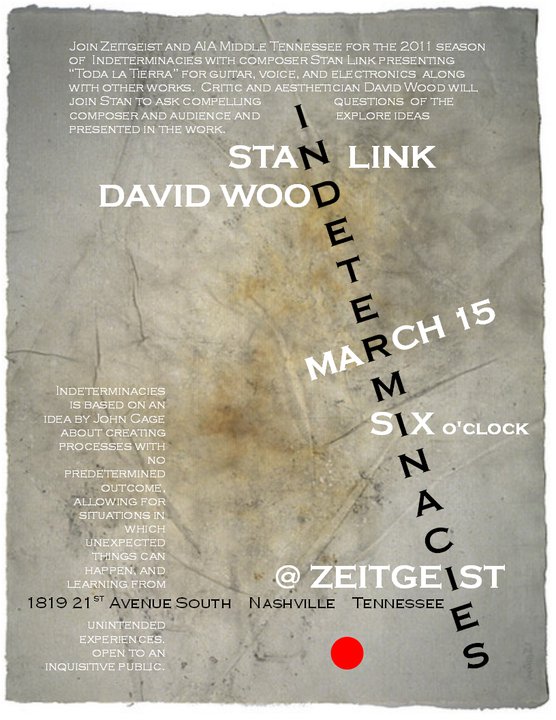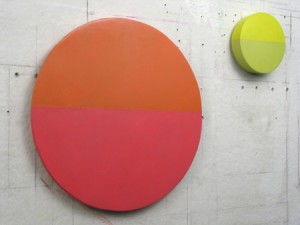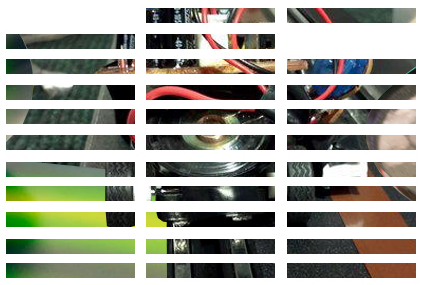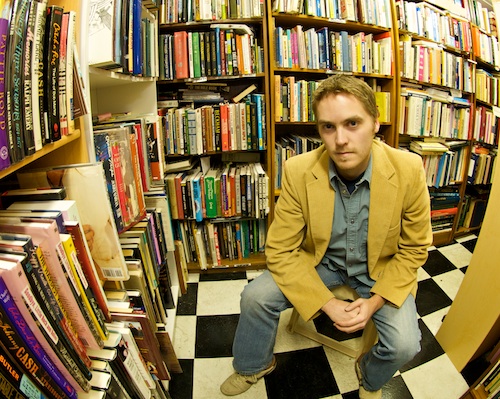
You’re admiring a snazzy shirt in the window of Clothing XChange in Nashville’s historic Hillsboro Village when your ears prick up to the sound of clanging metal, blistering saxophone, or cacophonous feedback. You trace the source up the block to a room fronted by a wall of glass. Through the window, you make out a crowd of people sitting in folding chairs and the back of a man vibrating enormous metal gongs with a cello bow. If not that, then you see a woman crouched on the ground manipulating boxes that contain a speaker and a microphone pair, feedback pitches rising and falling as she changes the pair’s distance. Or you see what appears to be a strange puppet show and can just barely hear its live score produced by some of Nashville’s most creative musicians. You furrow your brow, scratch your head, and eye the room for the entry door. The sign printed on the glass reads, “Zeitgest Gallery.”
On March 15th, Zeitgeist will kick off this year’s installment of its long-running Indeterminacies series with an interactive performance by composer Stan Link. Theatre Intangible interviewed two of the gallery’s curators — visual artist Lain York and architect Lesley Beeman — about the Indeterminacies series, Zeitgeist’s interdisciplinary philosophy, and its connection with experimental art.
TI: Can you discus Zeitgeist’s mission and tell us a little about its history?
Lain: Zeitgeist has been around since 1994 and operates somewhere between a commercial gallery, not-for-profit (museum-type space), and an artist-run space. Janice Zeitlin is the gallery owner, and Manuel Zeitlin is the principal architect/owner of Manuel Zeitlin Architects. The idea has always been to combine the gallery with the architectural firm and create a dialogue between fine art, architecture, and design. It’s a conversation that Janice and Manuel have always felt go hand in glove.
TI: What sets you apart from other local galleries?
Lain: Janice has always recognized the need to have a strong base of local artists and consistently digs a little deeper into the studio community. That particular community does work that is challenging and in most instances is more idea-based than what one sees in many of the other Nashville galleries. That helps bridge the gap between what our Nashville-based artists are doing and what is happening in more developed scenes. We probably do more in the way of programming outside the usual gallery scheduling (offsite temporary exhibitions, sound installations, experimental music performances/discussions, contemporary dance, theatre performances, poetry readings, etc.) in and outside the gallery than most Nashville-based spaces.
TI: Do you feel a kinship with any other local art spaces?
Lain: Definitely. We are members of the Nashville Association of Art Dealers and have participated in joint ventures with other commercial galleries such as art fairs, fund raisers, and First Thursday opening receptions. We have done group shows featuring local independent artists (artists with no gallery affiliation) and worked closely with artist run spaces such as Ruby Green and Fugitive Art Center. The gallery has sponsored curated shows from local independent artists, helped get them space, and provided equipment, mailing lists, and other resources. We also work closely with area museums, state and city arts commission, and area academic programs. The gallery has always seen the need for all spokes of the visual art industry wheel to roll together.
TI: Tell me a little about the current exhibit Therely Bare.

- “Parakeet (for Palermo, group 1)” by Kevin Finklea, Therely Bare Exhibit
Lain: Therely Bare is a show curated by two Chattanooga painters (John Tallman and Ron Buffington) that reaches into a particular blogging community of artists that were kicking around new ideas of abstraction related to painting. It brought together 16 artists from 6 countries who are, for the most part, artists of record (consistently showing in museums/commercial galleries, teaching on the university level, etc.). Some knew each other and, interestingly enough, were running into one another at recent exhibitions (Munich, New York, Paris); but most have not met physically. Lars Strandh came in for the Nashville opening from Oslo, and Billy Gruner and Sarah Keighery came in from Sydney, Australia. All of these artists were particular interested in showing in Nashville due to the fact that Robert Ryman (Ryman Auditorium) is from here and is the primary architect in the type of art/painting they all do. It was interesting to talk about the performance-based aspects of the show (Leopoline Roux, Billy and Sarah) in terms of what Red Grooms (another Nashville native) had done. Most Nashvillians only think of him as “the carousel guy” and know nothing of his role in the development of performance art and experimental film.
It’s a show curated from a studio community by that studio community that seeks to take back the conversation of what artists are doing from the industry: commercial galleries, academia, collecting base, museums, critical writing community, etc., etc.
TI: In addition to an art gallery and performance space, Zeitgeist is also an architecture and design studio for Manuel Zeitlin Architects. The firm has designed some of the most striking buildings in the Nashville, including Terrazzo and the Galante residence. What does an architect’s perspective bring to the gallery?
Lain: If we hang a show the architects don’t like we hear about it immediately; they are very involved in what Janice and I are bringing into the space. Zeitgeist has done architecturally-informed shows in the past and more design-oriented exhibitions such as a Memphis show (Italian design movement) but I think we could take the collaborated process further. Ideally, Manuel would love to see a residency program incorporated that would bring in architects from all over the world to collaborate on projects as Zeitgeist would like to see an incorporated studio program, not-for-profit project space, and art press.
Lesley: The gallery and the architecture firm have a kind of symbiotic relationship. Neither would exist in quite the same way without the other. The quality of the art shown in the gallery challenges the architects to push their work farther, it introduces ideas and design concepts that can inform our architecture. And, as Lain said, architects are not bashful critics. We push hard to see work in the gallery that we can draw from. From the architect’s perspective, when our clients come to our office/the gallery, they know they can expect creative, thoughtful, outside-the-box work.
TI: Describe your process for finding works to curate.
Lain: There are so many channels and increasingly it’s becoming more difficult to objectively process the amount of work out there. The criteria for what we look for is changing. The sheer number of artists is staggering and growing exponentially. The system (commercial galleries, museums, art professional and academic job markets, etc.) can not accommodate it all and (in my opinion) is breaking down. There has to be a re-thinking and overhaul of who artists are, what they do, and their relevance to the whole. Janice and I look at what individual artists are doing (our “stable” of associated artists who are on two year rotations for shows and new comers) but more increasingly we focus on what “groups” of artists are doing and what they bring to the table. We look for individuals who have strong bodies of work and actively finding outlets for what they doing. Conversely, we look at artists who are dropping out of the system and finding new vocabularies. I read a recent study that currently claimed only 2% of the artists in the US make their living solely off their artwork.
TI: On March 15th, the 2011 Indeterminacies series begins with a special performance by composer Stan Link, an associate professor at Vanderbilt University Blair School of Music. First off, what is the Indeterminacies series?
Lain: Indeterminacies is a performance based series (music predominantly) based on John Cage’s idea of processes whose outcome is not predetermined. This year Lesley and I are focusing on the composition community. We’re looking for composers/performers in the area that might be associated with academia or the professional community (or not) that are doing something different yet are very focused. Like the gallery, we give them a bit of rein to stretch out and push themselves to elaborate on particular ideas they might not otherwise get a chance to do otherwise. It supposed to be fun for the composers/performers and the audience. We try to incorporate an interactive aspect to it in that those who come to Indeterminacies will have the opportunity to directly participate in a discussion and in the performance itself. For the Stan Link/David Wood evening, patrons are asked to bring printed/written texts that will be incorporated into the performance. We left it up to Stan as to how these elements fit in (it was his idea) as to whether they were read, sung, etc. That’s the indeterminacy of the evening. We have no idea what’s going to happen.
Lesley: Last year, the wild card was that each program included audience participation as its primary objective. So, although we might give the audience very specific instructions, the outcomes are always surprising. People have a great propensity to not follow instructions and creative people seem to NEVER follow instructions. We create a space where you can play with the rules, try things you haven’t done, and find things you’d never expect. One of my personal favorite programs was when the folks from filmmakers Earnhardt-Pirkle gave us a brief primer on interviewing, gave us some flip cameras and sent us out into the community to collect interviews. The stories that were brought back were amazing. I think we changed the way people think about themselves and their community.
TI: What makes Stan an ideal fit for Indeterminacies?
Lain: We’ve been talking to him for a while now and this was a great project to pull him into. When Lesley and I first started talking about the series, the conversations were straddling two worlds; that of a very composed/academic one and one that was noisy and chaotic. Stan has a very academic background but we found the unexpected and chance elements of his work to fit the bill. We were also looking at the idea of acoustic instruments and electronics interacting and hoped to find individuals that were looking beyond tropes we were familiar with. (Like the visual art community) there are so many great people out there and only so many slots. We know we’re missing a lot but our overall goal is to push someone else into carrying the conversation further.
Lesley: Like the other presenters, if you give Stan a little rope he’ll take off. We just want to see there he’ll go. Stan has been working with Zeitgeist artist Will Berry on a collaboration of art and music based on South American antiquities. The musical work “Toda la Tierra” is on the program for the 15th. TI: Who are some of the Indeterminacies artists from the past and future? Lesley: This will be our fourth season of Indeterminacies, although its had other names in years past. We’ve had some strikingly diverse programs from chef Arnold Myint, nuclear physicist Victoria Greene, to sociologist Steven Tepper. I like to think that each year grows from the kernel of an idea planted in the previous year. This years series is based on a conversation we had last year that the library of criticism for new music, new ideas has to start somewhere. We married the idea of audience participation with a desire to develop a critical catalogue and created this series featuring composers of new music and critics.
Following Stan in April is an amazing talent, Mark Snyder. Mark is not only a great performer and composer, but directs a touring electronic music festival. He’s got works that involve processed tuba and accordion. What else can you say?
In May we’re hosting another local composer, Mark Volker, of Belmont Univ. Mark’s compositions make use of an incredible dynamic range and juxtaposes rhythms and melodies in odd ways.
In the fall we’re bringing in Andrew Raffo Dewar. Andrew is a crazy improv reed player, but like his colleagues in Indeterminacies, is also a PhD composer of beautiful string quartets. Andrew earned his chops playing for Anthony Braxton.
Ending the series is a composer I met many years ago who really introduced me to new, electronic music, John Latartara. We’re lucky that John is taking a teaching sabbatical to write new music and we hope he will be sharing it with us in November.
TI: That is a VERY exciting lineup! Some of my fondest concert-going experiences have happened at Zeitgeist, including intimate performances by Tatsuya Nakatani, Tristan Perich, and the dance/guitar duo of Charlie Rauh and Megan Harrold. What are some of your favorite moments at Zeitgeist?
Lesley: Wow! We’re happy you associate your fondest concert experiences with Zeitgeist. The Tristan Perich show was also a game-changer for me. He, Lesley Flanigan and Travis Weller really pushed what it means to craft sound. Musical performances are very fixed-in-time, so are the ones that spring to mind immediately, but some of the best moments are fleeting, like the instant when Alica Henry’s installation work suddenly speaks to you. But then, hell, working with Lain and the folks at MZA is the best gig I’ve ever had. TI: Aside from Indeterminacies, are there any upcoming shows in the works?
Lain: John Donovan is our April show and May features Patrick DeGuira and Brent Stewart. The Patrick and Brent show is not one to miss. Again, with the shows we try to find particular resonances and that one will reach deeply into several aesthetic communities. It promises to be an interesting crowd for some exciting work. September features Wayne White and Kurt Wagner (don’t think there’s much I have to say there; these guys are monsters).
TI: Zeitgeist is one of the few local spaces to experience avant-garde and experimental art. Why is Zeitgeist so receptive to such work? Why do you think the larger Nashville arts community is not?
Lain: Janice and Manuel are incredibly generous and have consistently been willing to take chances in the face of inconsistent sales. The gallery shows a pretty broad range of work and loses a few people because we are not full on cutting-edge contemporary (or because we throw in too much of the full on cutting edge contemporary) but we are having to balance a number of conversations. It’s what the environment is dictating, and we feel this is the appropriate response. In addition to being a commercial gallery, Janice and I feel that we are having to play the role of a museum (outreach), an academic program (education), and an artist-run initiative (a rallying point for a local, regional, national, international studio community). If Nashville had consistently had a responsive museum system, degree-seeking fine art academic programs, and a more effective and diversified commercial gallery system, we could focus on a particular aesthetic and function as a retail outlet. We don’t have that luxury, and it wouldn’t be any fun anyway. Frankly, I’ve always thought what Zeitgeist does is a unique business model.
TI: Zeitgeist has the most respectful and attentive audiences in Nashville, even during challenging works that some consider “noise.” The post-show discussions are always thought-provoking. What is it about Zeitgeist that makes the audience such an active part of the show?
Lesley: I think the difference is that with Indeterminacies the audience is considered integral to the event from its conception. We never think of the presentation and the Q&A as separate entities. When you come to Indeterminacies, expect to participate. Come prepared to fully engage with the program and with your fellow attendees…….. because there will be a quiz.
Lain: Again, it’s supposed to be fun but at the same time we feel we are table conversations that are already occurring. We seek to provide a platform for these “conversations.” I also think any “institution” has a responsibility to lead and not just give it’s constituency what it wants or expects. There should be some shows or elements that push boundaries and get under people’s skin and they should have the opportunity to voice their opinions. There’s no growth otherwise. I know we could push the envelope further but I feel that we want to keep patrons in the conversation. It’s a delicate balance.
TI: Who are some of your favorite local artists, musicians, and architects?
Lain: Where to being there… I would have to say that there are some real gems we have yet to fit into the programs the way we would like. As a painter, Joe Saunders who showed in the Right to Assemble show, gave me (and a lot of folks) plenty to think about. Greg Pond is always touchstone in the way that he designs and presents sound sculptures. I have always liked what Hands Off Cuba are doing and Lesley Beeman (of course) is my favorite architect; he’s currently working on a large sphere of water for me to live and work in.
Lesley: The Alias Chamber Ensemble consistently delivers amazing music. Their talent, knowledge and spirit of exploration make each of their performances not-to-miss events. If you haven’t heard them, seek them out now. They’ve just released CD of new music by composer Gabriela Lena Frank called Hilos.
TI: Who are some of your influences for your own art?
Lain: I have really enjoyed conversing with the Therely Bare artists.
Lesley: John Cage’s book “Silence” is the best book on architecture ever written.
TI: Lain and Lesley, thanks for your time!
See Stan Link and David Wood at Zeitgeist Gallery on Tuesday, March 15th at 6pm. 1819 21st Avenue South, Nashville, TN.





